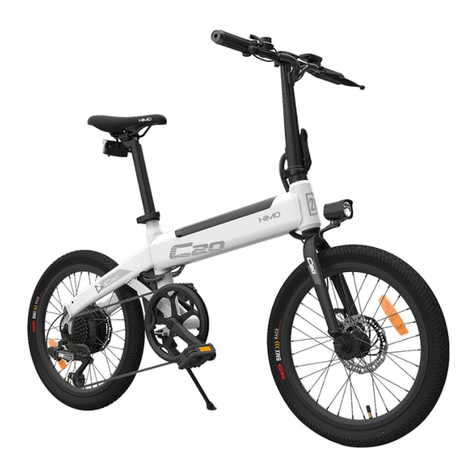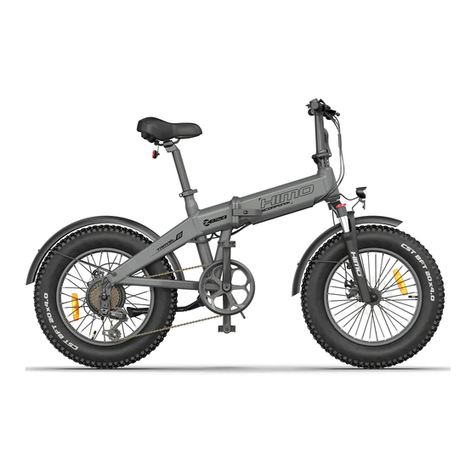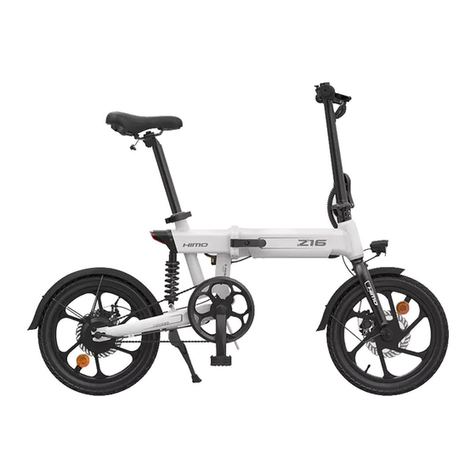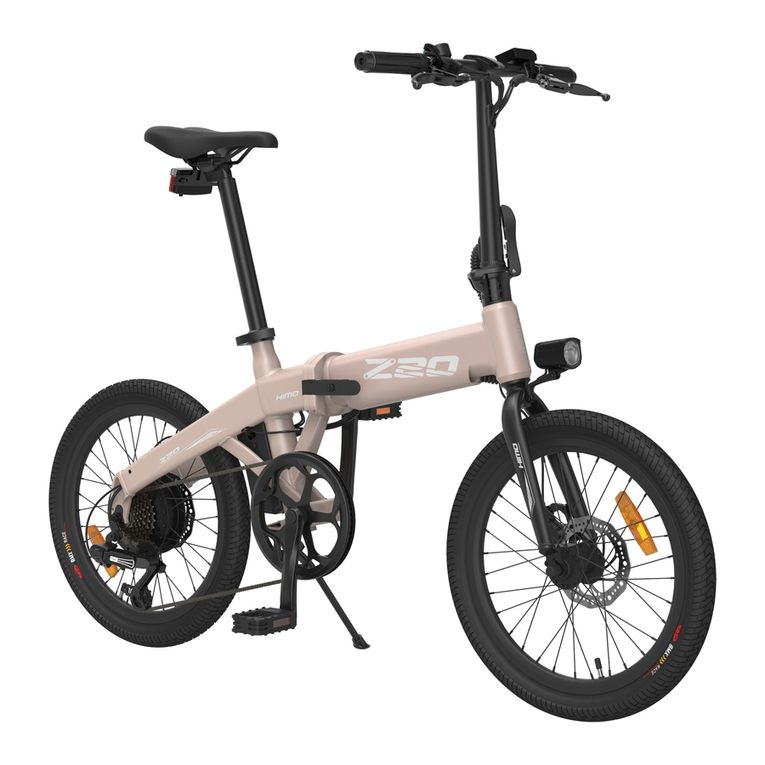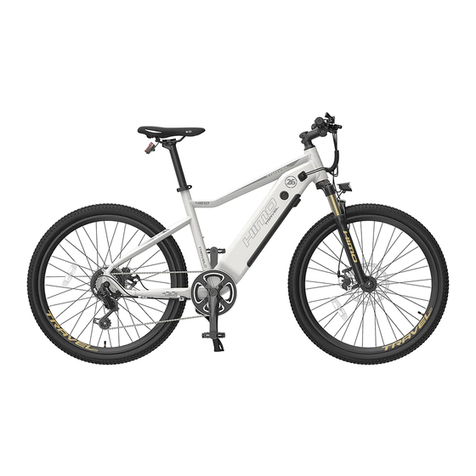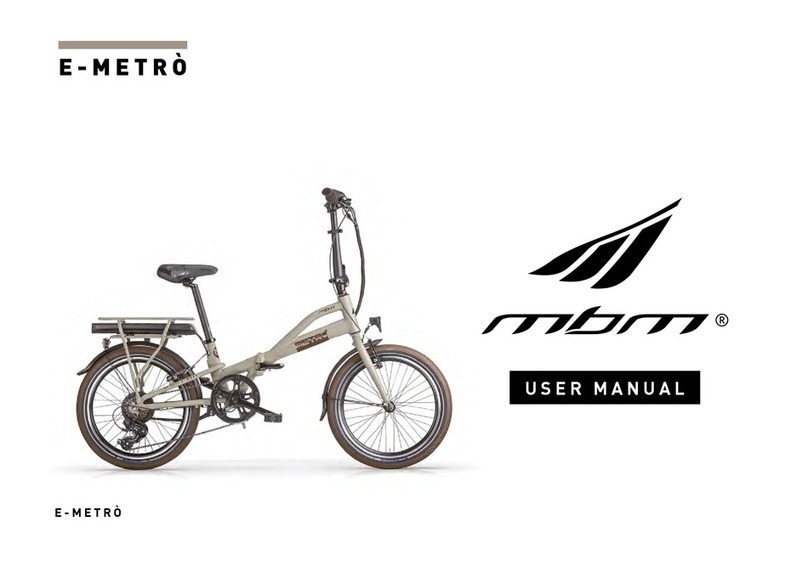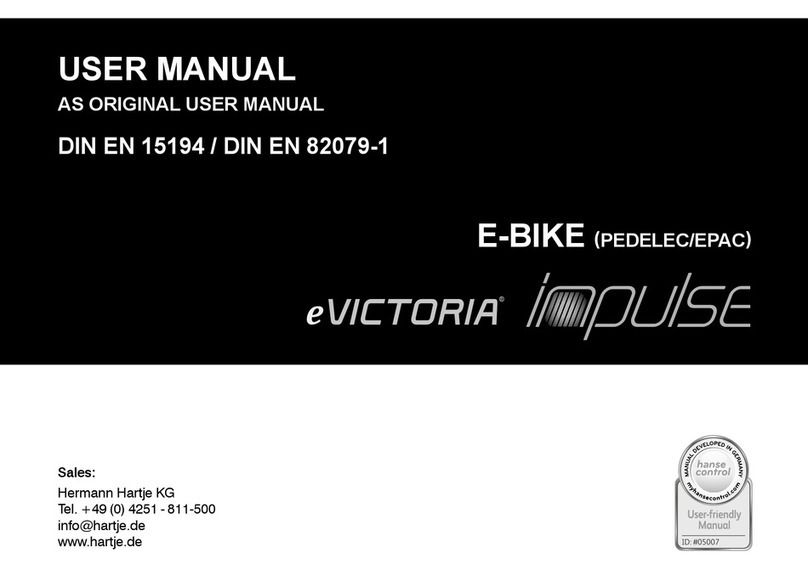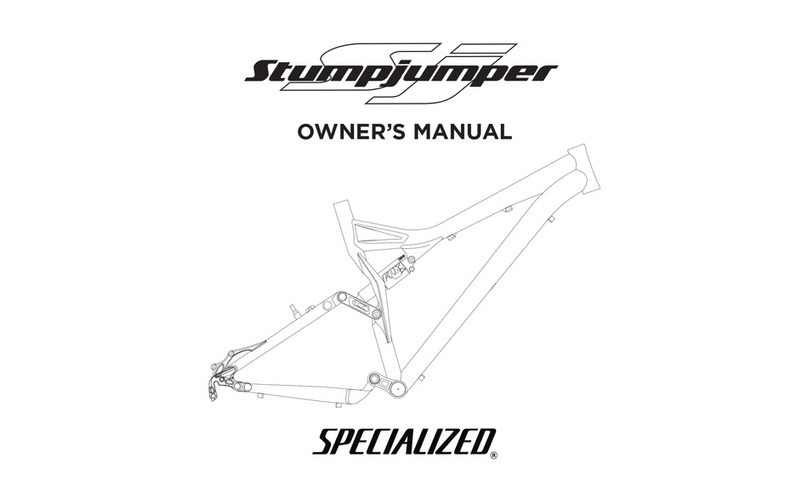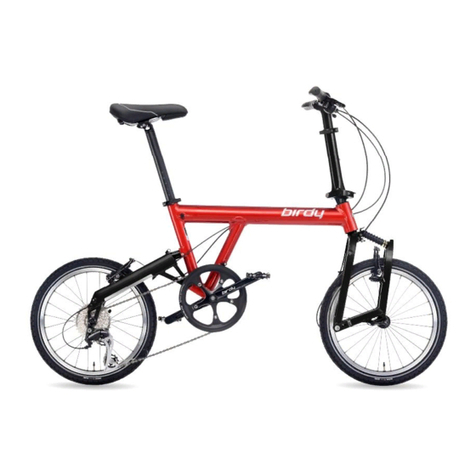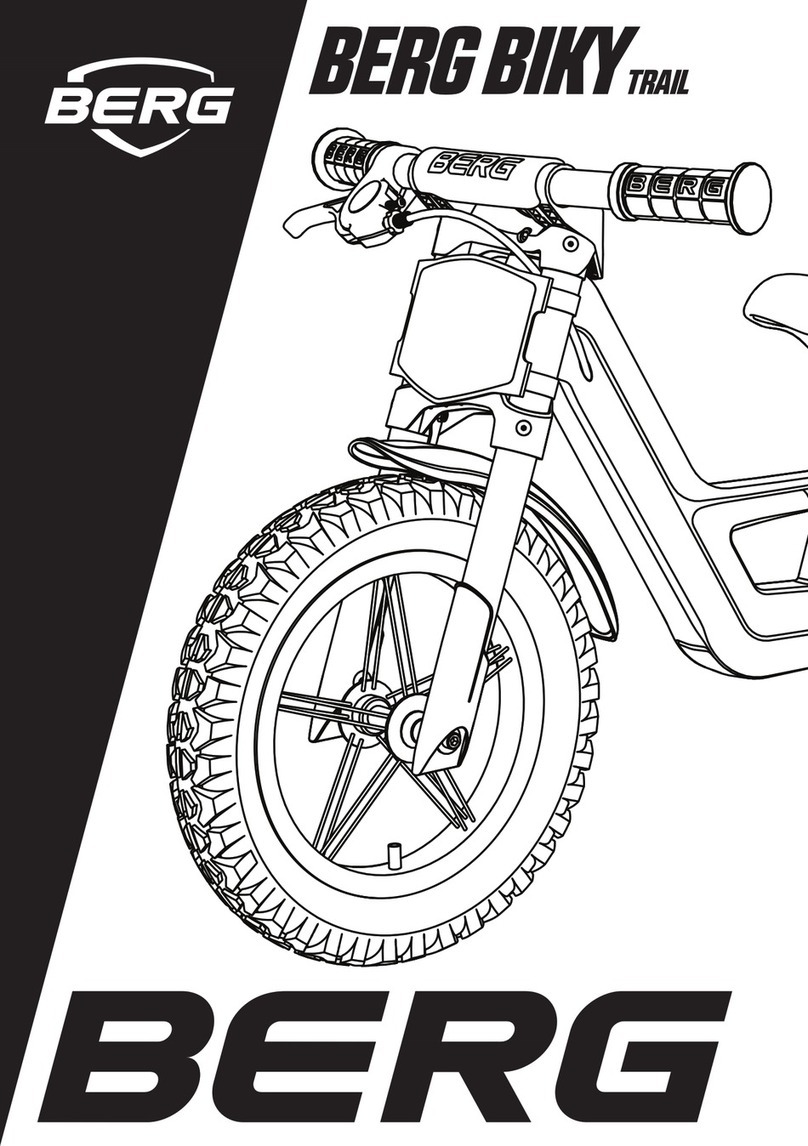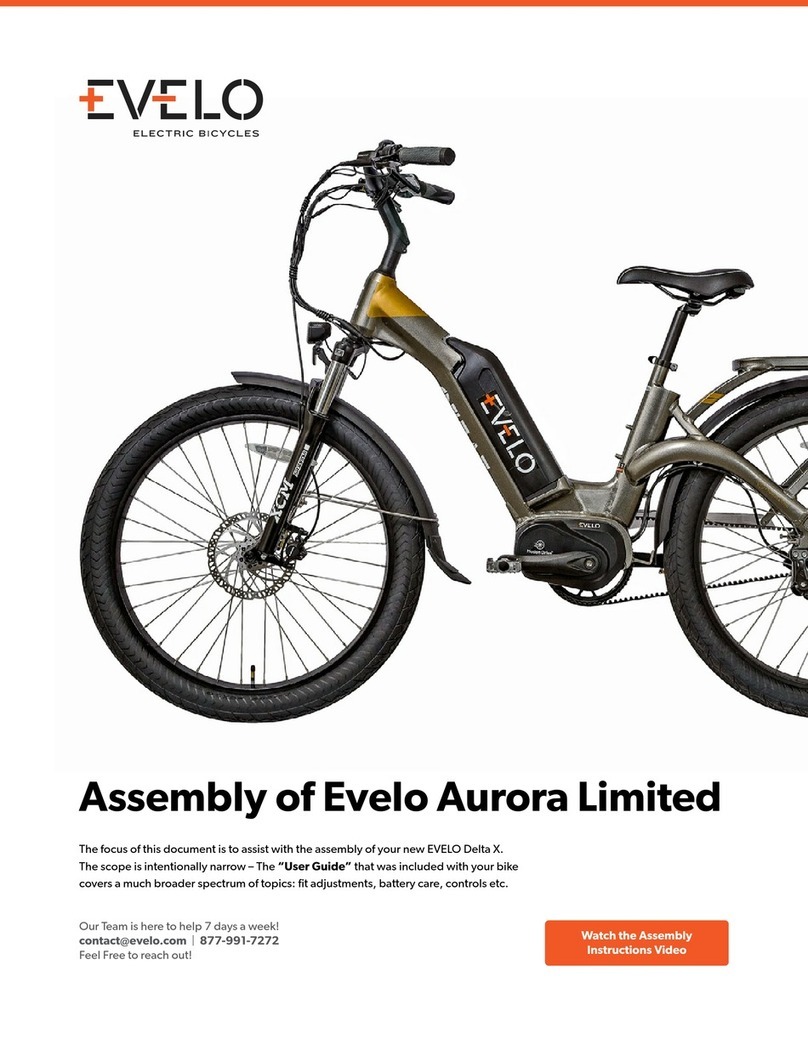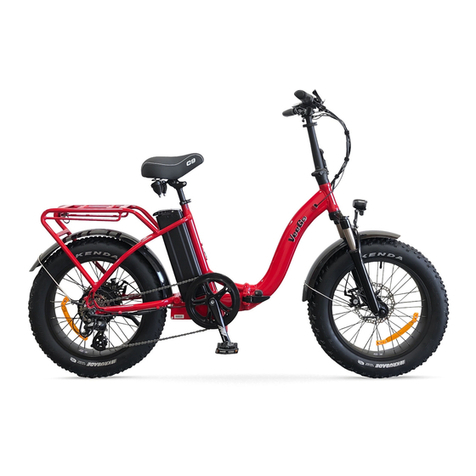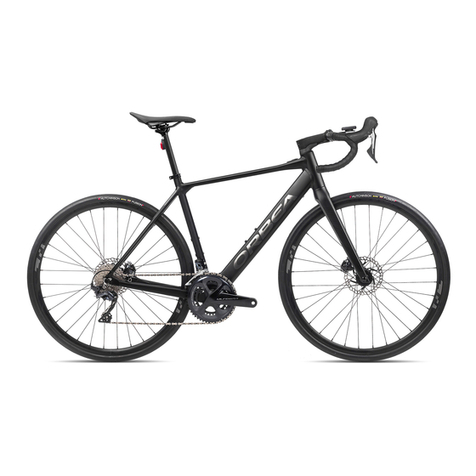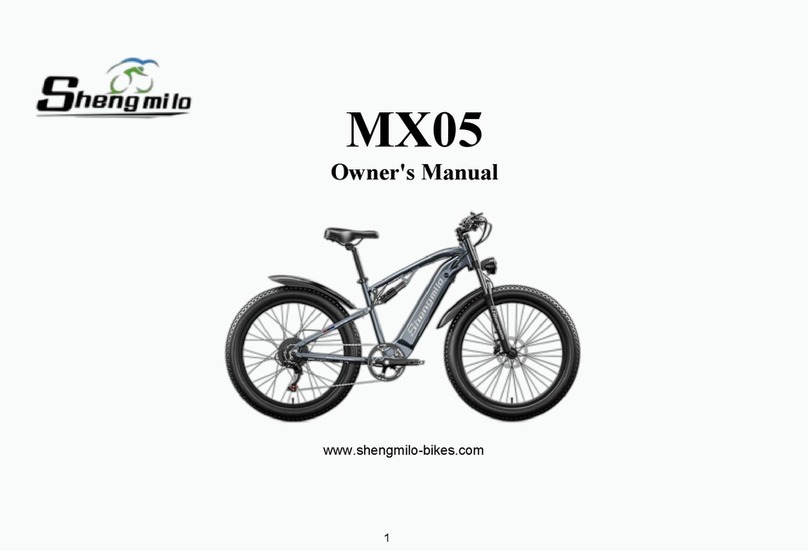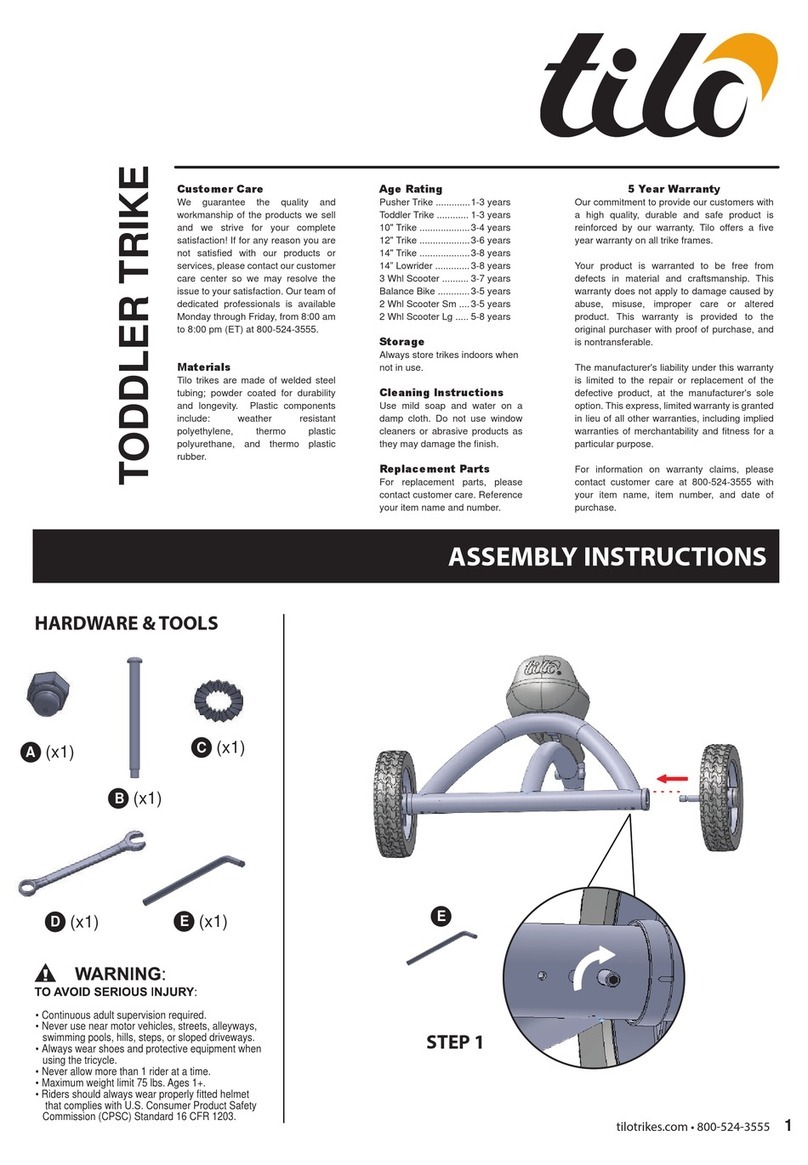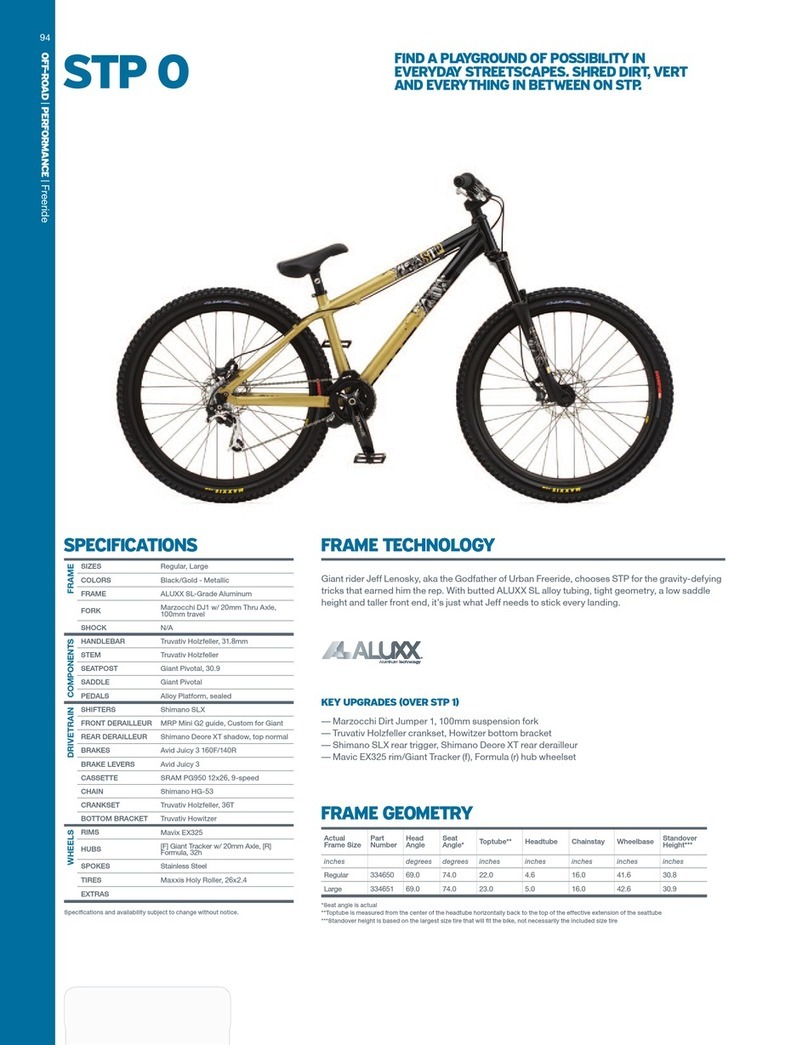HIMO C30R User manual

User Manual

Contents
Description of User Manual and Manufacturer.2
Safekeeping of User Manual ............................2
Text Design Feature .........................................2
Picture Design Feature.....................................2
Applicable Document .......................................3
Digital Copyright ...............................................3
Manufacturer’s Contact Information .................3
Safety Precautions ...........................................3
Intended Use........................................................3
Unauthorized Refitting Prohibited ........................4
Rider’s Body Type ................................................4
Qualification of User and Rider ............................4
Personal Protective Equipment............................4
Basic Safety Guidelines ...................................4
Avoidance of Damage to Bicycle......................5
Avoidance of Damage to Rider and Bicycle .....5
Important Notes, Labels and Signs on Bicycle
Safety ...............................................................8
Warning and Information Signs ........................8
Bicycle and Components..................................9
Power ............................................................. 11
Brake System ................................................. 11
Gearbox..........................................................12
Pedal ..............................................................12
Unpacking and Open-box Inspection .............12
Before Initial Riding ........................................13
Dimension Inspection.........................................13
Saddle Adjustment .............................................13
Handlebar Adjustment........................................14
Battery Charging ................................................14
Tire Pressure Inspection ....................................14
Bicycle Control ...............................................15
Brake..................................................................15
Speed Change ...................................................15
Light ON/OFF.....................................................15
Bicycle Unfolding................................................15
Bicycle Folding ...................................................16
Display Specification-500S ................................16
Power-on or Power-off....................................17
Power Level Selection........................................17
Riding .............................................................17
During Riding .....................................................17
Safety Precautions about Riding........................18
Power-assisted Riding .......................................18
Unpowered Riding..............................................19
Troubleshooting..............................................19
Bicycle Transportation ....................................20
Bicycle Maintenance ......................................20
Battery Maintenance ..........................................20
Maintenance of Motor and Controller.................20
Maintenance Plan ..............................................21
Service Record...................................................22
Bicycle Recycling ...........................................23
Warranty Clause and Condition .........................23
Additional Information.....................................23
Endurance Test ..................................................24
Test Method........................................................24
Component Fixation ...........................................25
Seat Post Adjustment.........................................25
Pedal Installation................................................26
Lubrication..........................................................26
Chain Tension ....................................................27
Gear Adjustment ................................................27
Wheel Set Damage and Wear ...........................28
Inflation Pressure ...............................................28
Description of Battery Maintenance and Charging.
...........................................................................28
Parts and Accessories List .............................29
Bicycle Card ...................................................29
Declaration of Conformity...............................30
C30R Screw Torque .......................................31

Description of User Manual and Manufacturer.2
Safekeeping of User Manual ............................2
Text Design Feature .........................................2
Picture Design Feature.....................................2
Applicable Document .......................................3
Digital Copyright ...............................................3
Manufacturer’s Contact Information .................3
Safety Precautions ...........................................3
Intended Use........................................................3
Unauthorized Refitting Prohibited ........................4
Rider’s Body Type ................................................4
Qualification of User and Rider ............................4
Personal Protective Equipment............................4
Basic Safety Guidelines ...................................4
Avoidance of Damage to Bicycle...................... 5
Avoidance of Damage to Rider and Bicycle .....5
Important Notes, Labels and Signs on Bicycle
Safety ...............................................................8
Warning and Information Signs ........................8
Bicycle and Components..................................9
Power ............................................................. 11
Brake System ................................................. 11
Gearbox..........................................................12
Pedal ..............................................................12
Unpacking and Open-box Inspection .............12
Before Initial Riding ........................................13
Dimension Inspection.........................................13
Saddle Adjustment .............................................13
Handlebar Adjustment........................................14
Battery Charging ................................................14
Tire Pressure Inspection ....................................14
Bicycle Control ...............................................15
Brake..................................................................15
Speed Change ...................................................15
Light ON/OFF.....................................................15
Bicycle Unfolding................................................15
Bicycle Folding ...................................................16
Display Specification-500S ................................16
Power-on or Power-off....................................17
Power Level Selection........................................17
Riding .............................................................17
During Riding .....................................................17
Safety Precautions about Riding........................18
Power-assisted Riding .......................................18
Unpowered Riding..............................................19
Troubleshooting..............................................19
Bicycle Transportation ....................................20
Bicycle Maintenance ......................................20
Battery Maintenance ..........................................20
Maintenance of Motor and Controller.................20
Maintenance Plan ..............................................21
Service Record...................................................22
Bicycle Recycling ...........................................23
Warranty Clause and Condition .........................23
Additional Information.....................................23
Endurance Test ..................................................24
Test Method........................................................24
Component Fixation ...........................................25
Seat Post Adjustment.........................................25
Pedal Installation................................................26
Lubrication..........................................................26
Chain Tension ....................................................27
Gear Adjustment ................................................27
Wheel Set Damage and Wear ...........................28
Inflation Pressure ...............................................28
Description of Battery Maintenance and Charging.
...........................................................................28
Parts and Accessories List .............................29
Bicycle Card ...................................................29
Declaration of Conformity...............................30
C30R Screw Torque .......................................31

Description of User Manual and Manufacturer
This User Manual is aimed at helping you use the electric folding bicycle safely. Unless
otherwise specified functionally, the electric bicycle is hereinafter referred to as “bicycle”.
This User Manual is prepared according to IEC 82079-1 (preparation of planning, content
and demonstration).
Safekeeping of User Manual
This User Manual is a part of the bicycle.
Keep this User Manual properly together with the bicycle.
Ensure the user can obtain this User Manual easily.
Provide this User Manual while selling or distributing the bicycle.
Text Design Feature
All elements of this User Manual present fixed design features in order to distinguish from:
Common text
Action steps
First-level list
Picture Design Feature
The pictures may contain numbers corresponding to components and descriptions are
given to corresponding numbers below the pictures.
Applicable Document
The manufacturer’s documents contain additional information and illustrations about
bicycle components, which are also a part of this User Manual. Please keep them properly
together with this User Manual and present them while selling or distributing the bicycle.
The risk of injury may be caused by violation of regulations of relevant documents.
Please read and comply with all other applicable documents before using the bicycle.
Applicable document includes the following documents:
Declaration of Conformity
Digital Copyright
Information contained in this User Manual shall be copyrighted. Without HIMO’s written
consent, this User Manual shall not be duplicated, printed, photographed, handled or
distributed in any form.
The ownership shall be reserved by HIMO.
Manufacturer’s Contact Information
SHANGHAI HIMO ELECTRICAL TECHNOLOGY CO., LTD.
Room K50, 1F, Building 6, No. 4299 Jindu Road, Minhang District, Shanghai City
Tel: +86(021)37655820-817
Email: [email protected]
Website: www.himo-tech.com
Safety Precautions
Intended Use
The bicycle shall be used by one person and can be used in auxiliary roads and public roads.
The tires must always be in touch with the ground during riding. The bicycle shall be used for
private purpose only and cannot be used for other purposes. Necessary safety equipment
must be adopted in use, which shall be included in the assembly list.
The bicycle is not applicable to:
Jump
Stair riding
Deepwater riding
Sports event
The intended use also includes maintenance conducted as per the recommend time
interval and reading and comprehension of this User Manual.

Unauthorized Refitting Prohibited
Refitting or refitting the bicycle improperly, especially improper operation and refitting of the
motor and the controller, may result in serious damage beyond the warranty scope.
Be sure not to refit the controller or the motor by any means.
Only the batteries attached can be used.
Be sure not to connect positive and negative poles of the batteries.
Protect the batteries from direct sunlight.
Please do not dismount or clean the batteries.
Only the charger attached can be used to charge the batteries.
The charger can be used indoors only.
The charger plug is used to cut off the power. Please ensure the power socket is close to the
charger for user-friendliness.
The charger can be used for 230V grounding receptacle only. Please be sure to prevent the
charger from water or any type of liquids.
Keep metal contacts clean and clean them using soft dry cloth when necessary.
Please do not charge batteries with damaged case and other obvious damages.
Please prevent the batteries from falling off.
Charge the batteries at a temperature of 10-30℃.
Ensure the charger is used by people without physical, sensory or mental disabilities only.
Electric shock or explosion may be caused by improper use of batteries and the charger and
consequently severe injury or death may be caused.
Body parts or other objects may touch chain wheel, mobile chain, rotating pedal, crank and
wheel of the bicycle during riding and consequently severe injury will be caused. Please be sure
to avoid contact between body parts and the aforesaid parts.
Rainy and humid weather will the rider’s and other road users’ traction, braking force and
visibility. In this case, your (and other road users’) braking force will decrease exponentially,
tread pattern has work efficiency inferior to dry pavement’s, it is more complex to control speed
and the rider will lose control of their bicycle, and consequently severe injury may be caused.
It is more dangerous to ride a bicycle in the dark at night than in the day and it is harder for the
rider to identify other road users, and consequently severe injury or death may be caused.
Please avoid contact between body parts and the aforesaid parts of the bicycle during riding.
Rider’s Body Type
At least 170cm
At most 190cm
Qualification of User and Rider
Personal Protective Equipment
This User Manual is applicable to educated rider.
The rider should have the following knowledge and experience:
Severe injury or death may be caused during riding.
Please be sure to wear a certified helmet in riding, and adjust, use and maintain the helmet
according to the manufacturer’s manual.
Please be sure to wear sun glasses in sunny days.
Please be sure to wear secure shoes with non-slip soles (such as special-shaped rubber
soles).
Please be sure to wear gloves.
Please be sure to wear tights to avoid being caught by the bicycle or objects on the road.
Please be sure to wear (transparent) dirtproof, dustproof and mothproof glasses.
Please be sure to carry out safety test before riding.
Please get familiar with the brake, pedal and gear before riding.
Please be sure to adjust the riding speed as appropriate.
Use the bicycle descried in the distributor’s User Manual effectively;
Realize that improper use of the bicycle may cause an accident
Able to use the bicycle as requested by this User Manual
Basic Safety Guidelines
Avoid severe injury or fatal injury caused by mechanical failure and improper use of the
bicycle.
Severe injury and even death may be caused by mechanical failure or improper use during
riding.
Avoid electric shock or explosion caused by improper operation of
battery and charger.
Avoidance of Damage to Bicycle
Avoidance of Damage to Rider and Bicycle
Avoid severe injury caused by contact between body parts and parts of the
bicycle
Avoid severe injury or death in rainy days
Avoid severe injury or death in the dusk or in the night
Please be sure to ride a bicycle slowly in rainy and humid weather.
Please be sure to brake carefully in rainy and humid weather.
Turn off the motor or try to reduce the motor power and ride a bicycle carefully.
Do not ride a bicycle in the dark at night.
Please be sure to ride a bicycle carefully.
Please be sure to use light and reflector while riding a bicycle.
Please be sure not to ride a bicycle in the dark and in rush hour.
Please be sure to keep off obstacles on the road.
If possible, please be sure to ride a bicycle on a familiar road.

The rider is allowed to ride a bicycle on the approved road.
In case of obstacles, please carry the bicycle.
In case of damage, please inspect the bicycle at the distributor.
Request the distributor to replace the damaged, bent or loose reflector and the light.
Inspect the reflector and the light regularly.
Avoid severe injury caused by damaged parts
The motor, crank or bottom bracket may be damaged while riding a bicycle in the country-
side or on the curb, and consequently severe injury may be caused.
The reflector can capture and reflect light of street light, car headlight and other light sources
so that the rider is easy to identify. The rider may be hard to identify if the reflector is
damaged, bent or loose and consequently severe injury or death will be caused.
To avoid such accidents, you should:
Avoid severe injury or death caused by damage or looseness of reflector and
light
Please be sure to adjust the riding speed as appropriate.
Replace parts or add accessories appropriately in order to avoid severe injury or death.
Please be sure to consult the distributor before installation, use and maintenance of
components.
Please be sure to read and comply with the instructions attached.
Only activities set forth in the maintenance plan can be carried out.
Only commercially available lubricant and detergent can be used.
Only qualified distributor can carry out maintenance and repair.
If the speed is not controlled properly while riding in the countryside or in the sidewalk, the
rider may fall down and consequently severe injury or death may be caused.
Improper maintenance, repair and cleaning may result in severe injury or death.
Inspect wear of all parts (such as brake block and tire) regularly.
Qualified distributor/specialist shall replace (if possible) or repair the damaged parts.
The bicycle and parts thereof will be worn (scratch, crack, wear and color change). The
damaged parts may break down suddenly and consequently injury and death may be
caused.
Please be sure to store the bicycle in a well-ventilated room.
Cool hot parts down before use or wear thermal protection device.
Brand new materials (such as oil paint) and high-temperature motor will produce volatile
gases. Volatile gases will gather when the bicycle is stored indoors and consequently difficult
breathing and suffocation may be caused.
Parts of the bicycle (brake and tire) may heat up during riding and burn injury may be caused
by touching these parts.
In this case, please inspect the bicycle at the distributor immediately.
If necessary, install an ergonomic saddle suitable for women/men.
When necessary, adopt preventive measures.
The legs may be injured (relating to Q value) if the space between the pedals is too small.
The rider may feel uncomfortable with the pedals.
The bicycle can be used on the approved road only.
In case of crack or obvious damage, please consult the distributor/specialist about mainte-
nance.
Inspect whether the parts makes a correct response (e.g.: Shift the gear on a flat surface)
and whether they function well before riding.
The rider is allowed to ride a bicycle on the approved road only.
The motor may work abnormally in case of improper assembly, wear and overload (e.g.: The
motor is powered in the bumpy pavement and on the curb) or loose parts.
Men may have prostatic diseases after sitting on the saddle long and frequently.
Please be sure to supply sufficient liquids. Please inspect the bicycle at the distributor.
Riding is a strenuous physical activity.
Please be sure to wear suitable clothes in cold weather, including face shield, mask and
gloves.
Please be sure to test power function before initial riding.
Please be sure to wear personal protective equipment.
Please be sure to inspect default speed settings of the bicycle.
Please be sure to thoroughly inspect braking force, speed and function before riding.
Cold injury may be easily caused while riding in cold weather
The bicycle may be out of control and overturned due to sudden power.
Abandon waste batteries and electrical/electronic components of the bicycle according to
laws and regulations.
Please comply with the manufacturer’s instructions during operation.
Ensure batteries are not fully discharged.
The batteries can be stored in a dry place only.
Please charge the batteries at least once every half year.
The damaged parts (such as battery and electrical or electronic components) of the bicycle
may produce toxic substances or gases and consequently environmental poisoning may be
caused.
Property losses may be caused by improper use of battery.
Many components and accessories can improve comfortableness, performance and
appearance of bicycle. The risk of adding components or accessories shall be borne by the
user, since such components or accessories may not pass the test on compatibility, reliability
or safety conducted by the manufacturer. Uncertified compatibility, reliability or safety and
improper installation, use and maintenance of components or accessories of bicycle may
result in severe injury or death.
Avoid severe injury incurred while riding in the countryside or on the curb
Avoid injury in the legs
Avoid vibration
Avoid severe injury or death caused by damaged parts
Avoid severe injury caused by improper maintenance, repair and cleaning
Avoid difficult breathing and suffocation
Avoid burn injury
Avoid injury or uncomfortable experience
Avoid dehydration while riding
Avoid cold injury
Avoid falling down due to sudden power
Environmental issues
Avoid material damage

Pay attention to the following warnings in this User Manual:
Warnings marked with “WARNING” are given against potential hazards
and shall be avoided; otherwise, death or severe injury may be caused.
Warnings marked with “CAUTION” are given against slight injury or
moderate injury.
Such warnings are given against material damage.
Sign Description
Ensure all warning and information signs on the bicycle are legible.
Replace the damaged or lost warning and information signs immediately.
Description
Important Notes, Labels and Signs on Bicycle Safety
Warning
Warning
Warning
Design features of material change:
The bicycle is provided with the following warning and information signs.
Warning and Information Signs
Common warning sign
Hot surface
Please do not use high pressure washer
Please follow the instructions during operation
Please be sure not to turn on the motor and the controller
Bicycle and Components
The folding bicycle should be used in auxiliary roads and public roads and it can be folded
using existing joints and hinges through several simple steps. Necessary materials are often
included in the assembly list. Please ensure safety equipment is in place and at working
condition before initial riding. Materials should be assembled by the user or the distributor.

The motor of the bicycle directly acts on the rear wheel and helps the user step on the pedal.
The user can adjust the power of the motor using existing control system and select different
grades of riding. The motor enables the maximum speed of 25km/h.
The power-assisted system should be furnished with batteries, which are installed in the
frame.
The batteries can be removed using the key and charged. Only the charger attached can be
used to charge the batteries.
Like most large batteries, lithium ion battery is a hazardous substance according to
transportation regulations. The bicycle cannot be transported before the battery pack is
installed. For air transportation, regulations on hazardous substances should prevail.
(Please comply with local transportation regulations)
The packing box of battery pack must be marked with Danger during transportation.
DescriptionNo.
DescriptionNo. DescriptionNo.
DescriptionNo.
Instrument
Handlebar
Shift lever/Brake crank
Front light
Side reflector of front wheel
Front disc brake
Saddle
Tail light
Saddle tube
Saddle tube quick release
Battery
Charging port
Chain
Pedal
Ladder
Brake cable
Adjust screw of brake
Brake arm
Locking screw of brake
Brake lining
Brake disc
Rear gearbox
Motor
Side reflector of rear wheel
Rear disc brake
Bicycle
Motor
Preassembled bicycle, including batteries
Charger
Two keys used to dismount the batteries (one for standby)
The packing list of the bicycle includes:
Power
Brake System
Battery pack
Controller
Disc brake
The bicycle is furnished with a controller to adjust the power, which is controlled using the
handlebar. The power of the controller is calculated according to preset speed, actual speed
and pedal stress. The maximum speed is 25km/h. Power is not supplied above the
maximum speed.
The brake is installed on the front wheel and the rear wheel. The disc brake block acts on
the disc to slow down. The brake disc will be worn and is controlled by the handlebar. The
disc brake is a mechanical drive.
The brake can control the bicycle to slow down or stop

Warning
Gearbox Dimension Inspection
Saddle Adjustment
Gearbox
Downshift means to shift to a lower gear so that it is easier to step on the pedal.
Upshift means to shift to a higher gear so that it is hard to step on the pedal.
The gearbox shifts gears on the condition that the drive chain moves forward and is at least
at tense state.
The user can select a suitable gear as appropriate.
e.g.: Shift to a higher gear to speed up in advance before climbing up a hill in order to save
power.
The pedal is installed at the end of the two cranks. Step on the pedal and the chain rotates
to drive the chain wheel.
Unpack the bicycle as follows:
Inspect whether two pedals are correctly and fully tightened (to the last thread). Try to
tighten the pedals and inspect them. Tighten the right pedal (on the side of the shifter)
clockwise and the left pedal (on the side of the kickstand) anticlockwise.
The risk of suffocation may be caused by playing with aluminum foil.
Children may be suffocated by wearing aluminum foil on the head.
Prevent children from playing with aluminum foil.
Keep the film out of children’s reach.
The rider may fall down if the seat post is damaged and consequently
severe injury may be caused.
Ensure the minimum insertion mark (minimum insertion amount) on the
seat post is in the seat tube and invisible.
The bicycle is furnished with gearbox.
Meaning of the following terms is as follows:
The gear box or threaded chain wheel on the rear wheel
Rear gearbox
Tray/chain ring
Drive/driven chain
Shift level/gear lever
Open the box.
Take the bicycle out of the box.
Take the battery charger out of the box.
Take two keys used to dismount the batteries out of the box.
Inspect assembly list.
Prevent children from playing with packing film in order to avoid suffocation.
Dispose of packing materials according to local instructions and regulations.
The gearbox consists of the following parts:
Pedal
Unpacking and Open-box Inspection
Pedal
Before Initial Riding
It is of great importance for safety, performance and comfortableness to adjust the bicycle
properly. The user should have certain experience and adjust the bicycle using special tool
according to physical and riding conditions; otherwise, the bicycle should be adjusted by
specialist. If the user has experience, knowledge and tool, please accept the inspection
conducted by specialist.
The bicycle may fall down due to improper dimension and out of control
and consequently severe injury may be caused.
Ensure dimension of the bicycle is consistent with the user’s height.
Please do not ride a bicycle not consistent with your height.
It is of great importance for safety to adjust the saddle correctly. The user can adjust height
of the saddle freely.
Please inspect whether height of the saddle is adjusted correctly as follows:
If your legs do not extend completely when your feet are put on the pedals, height of the
saddle is adjusted correctly.
Please adjust height of the saddle as follows:
Then, move the saddle up and down and adjust the height.
Sitting on the saddle, the rider can tilt the elbow to operate the brake rod and the shift lever
correctly.
Sit on the saddle
Keep being seated
Place a pedal downward
Put feet on the pedals
Release and open the quick release seat post clamp.
Close the quick release seat post clamp to reinstall the seat.
Inspect whether height of the seat is adjusted correctly.
If not, repeat adjusting steps.
Warning
The handlebar, the rider’s response to steering and braking can be
adversely affected;
Warning
Adjust the saddle as needed.
Warning

Handlebar Adjustment
Adjust the handlebar of the bicycle
Please adjust the handlebar of the bicycle as follows:
The brake is used not only to stop the bicycle but also to control the speed. The maximum
braking force of the tires refers to the stress when the tires are “locked” (do not rotate) and
slide. In case of tire slip, most braking force will be lost and the bicycle will be out of control.
Please brake gently and stop the bicycle slowly, namely progressive braking skill, to
prevent the tires from being locked.
The light is powered on by built-in batteries. Please ensure the batteries are fully charged
while riding at night.
Turn on or turn off the light as follows:
Turn on the switch of the front light.
Turn on the light even in the day so that it is easier for other road users to identify the
bicycle.
Push the brake to the handlebar to increase the braking force gradually.
If the wheels are stuck, please release the brake so that the wheels can rotate and are
not stuck.
Open the front cover on the stem.
Put on the handlebar and adjust the angle properly.
Lock the front cover on the stem.
The batteries may explode if a wrong charger is used and consequently
severe injury or death may be caused.
Only the charger attached can be used.
Read and comply with the instructions in the charger specification.
The batteries should be charged at a temperature of 10-30℃.
Please charge the batteries as follows:
Take out the batteries.
Ensure no damage of battery case and other visible damages.
Please charge the batteries on the surface of non-flammable objects,
e.g.: ceramics.
Comply with the instructions in the charger specification (if contained).
Insert the charger plug into the socket on the batteries.
Insert the charger plug into a 230V and 50Hz power socket and the light on the charger
will be red. It takes 5-6 hours to charge the batteries. When the light turns green, it
means that the batteries have been fully charged.
Remove the plug from the socket.
Remove the plug from the battery socket.
Reinstall the batteries.
The user can identify the permissible inflation pressure range on the side wall of the tires.
Test inflation pressure of the tires.
Foot pump with pressure gage/pressure meter is recommended to inspect and correct tire
pressure.
Battery Charging
Warning
Tire Pressure Inspection
Bicycle Control
Brake
Light ON/OFF
Speed Change
To speed up, start with a lower gear at the beginning, and change to a higher gear as the speed
increases.
The speed will decrease when going uphill. Lower the gear to maintain a certain pedaling force
The speed will increase when it is downwind, Increase the gear to maintain a certain pedaling
force
①: Toggle it to downshift, making it slower and more labor-saving
②: Toggle it to uplift, making it faster and more laborious
Laborious Effortless
Slow
Fast

Press and hold “ ” for about 3s.
Power-on or Power-off
Power Level Selection
Light ON and OFF
During Riding
Please turn on the display as follows:
According to the selected power level, power exercise can help you step on the pedal.
Five power levels are optional:
Please select the power level as follows:
Turn on the controller
Press “+” again to select a higher power level.
Press “-” again to select a lower power level.
Please be sure to wear a helmet consistent with the latest certification standard during
riding. For adjustment, use and maintenance of helmet, please refer to the manufac-
turer’s specification. Most severe injuries are caused to the head during riding, which
can be prevented through wearing a helmet.
According to regulations on release of road traffic permit, the following equipment is
needed for riding a bicycle safely on public roads:
A bell
Two independent brake systems
White front light
Front white reflector
red rear light
rear red reflector
Two yellow reflectors are installed on the spoke of every wheel with a deviation angle
of 180° or a white reflector is installed on the tire.
A yellow reflector is installed on the front and rear pedals.
The batteries have been fully charged
The brake, chain guard and fender work normally
The handlebar is connected securely and adjusted properly
The saddle is connected securely and adjusted properly
The pedals are connected securely
The wheels are connected securely
The tires are connected securely
Tire pressure is correct
The lights are normal and are adjusted properly
The circuits are normal and are adjusted properly
The quick release screw, nut and operating lever are secure
The front light should be approved according to regulations of the host country/area.
Before riding, make sure that:
Press and hold “ ” for 3s to turn on the light.
Press and hold “ ” for 3s to turn off the light.
Please turn off the display as follows:
Press and hold “ ” again for about 3s.
Riding
Display Specification-C30R
Part description
Power indicator
Up key
Down Key
Headlight indicator
Brake indicator
Battery level
Speed display
Mode and mileage display
Gear display
Logo and error code display area
Power key
Mode key
No. Part description
No.
■1 ■2 ■3 ■4 ■5

Fully comply with regional traffic laws and regulations on bicycle. Comply with regulations on
bicycle registration and riding on sidewalk and laws on the use of bikeway. The user is obliged
to get familiar with and comply with laws and regulations.
Respect the rights of motorway users, pedestrians and other riders on the same road/bikeway.
Keep the lights on.
Ride a bicycle foreseeingly. Please be sure to suppose that others cannot see you.
Observe before crossing the road.
The car ahead brakes or reverses and the car behind approaches
The door of a parked vehicle is opened
Pedestrians in the street
Children or pets playing on the roadside
Pit, trench, railway and expansion joint
Construction of road or sideway, rubbles or other obstacles which may force you to use the
opposite lane
An accident is caused by evading or being caught by the bicycle or losing control
Ride in the designated bikeway or ride as close to the roadside as possible according to
regional regulations or along the traffic direction
Park in front of parking sign and traffic light. Observe around while braking at the intersection.
Remember that a rider is always the weakest road user
Please use common gestures while turning a corner or parking
Be sure not to wear a headset while riding since it can shield the whistle easily
Traffic noise and whistle may distract the rider and make the rider out of control
Be sure not to carry anyone while riding. Eligible helmet and correctly installed child seat or
baby cart must be used to carry infants. For weight restrictions, please follow the manufactur-
er’s suggestions for child seat or baby cart
Be sure not to carry any objects which will obstruct the rider’s view, will affect the rider’s control
over the bicycle or will be stuck by moving parts of the bicycle
Please avoid being dragged by other vehicles while riding
Please do not perform special effects, ride on a single wheel or jump; otherwise, the bicycle may
be damaged
Be sure not to cross the road, ride around and behave in the ways that other road users cannot
predict
Ride a bicycle foreseeingly and pay attention to order of importance and emergency
Be sure not to ride after drinking wine or taking drugs
Try not to ride in severe weather, at poor visibility, in the dusk, in the night or under fatigue;
otherwise, accident risk will increase.
If you have never ride a power-assisted bicycle, please get familiar with it in an open space. The
power device will be activated only after it is powered on and the rider is stepping on the pedal. It
may be a little uncomfortable in the beginning, but the rider will get used to it soon. The rider should
set on the saddle before stepping on the pedal.
Do daily exercise from the minimum level of riding, e.g.:
Stop stepping on the pedal and the power-assisted system will still provide power within a short
time.
The power-assisted endurance mileage is determined by the following factors:
Starting
Accelerating
Braking
Turning a corner
Total weight of bicycle, rider and luggage
Speed control
Tire pressure
The user also should make the following preparations:
Troubleshooting
Safety Precautions about Riding
Unpowered Riding
Power-assisted Riding
Battery level
Road condition
Weather
Following the wind or against the wind
Personal energy
Ensure the batteries have been fully charged.
Ensure tire pressure is adjusted properly.
Do not use or select a low power level on the flat ground or a downward slope.
Select a suitable gear according to riding condition.
Please turn off the power-assisted system while riding for a short distance in order to avoid
unnecessary start and stop.
To reach the maximum mileage, please follow the steps below:
You can also use an unpowered bicycle. Turn off the power-assisted system and the bicycle is an
unpowered bicycle.
e.g.: When the batteries are exhausted.
The display does
not work
The green light of
the charger lights
up, but the
batteries cannot
be charged
Please be sure to
connect the charger
to the batteries and
then insert it into
the socket in the
wall
The batteries have been
exhausted or the bicycle is not
connected to the batteries
The batteries are not
connected to the charger
correctly
It may be caused by adverse
wind, mountain road, rider’s
weight, speed adjustment and
tire pressure
Please be sure to connect the
charger to the batteries and
then insert it into the socket in
the wall
Ensure the batteries have been
charged and installed correctly.
Ensure the batteries have been
locked in order to avoid
disconnection between the
batteries and the bicycle during
riding
Problem Possible cause Solution

The folding bicycle may fall off or slip off during transportation and consequently
severe injury may be caused. The bicycle should be protected from turning over,
slipping off and falling off when transported by vehicles or public transportation
facilities.
Please transport the bicycle using certified luggage carrier.
If there is no luggage carrier, the bicycle must be placed in the trunk (it cannot be
placed on the gearbox).
Moisture, pollution or mechanical damage may cause short circuit and consequently
a fire or battery explosion may be caused.
Clean the motor and the controller using wet sponge from outside.
If the motor and the controller are immersed in water accidently, please pull out the
plug immediately and disconnect the motor and the battery. Consult the manufacturer
before powering on the motor again.
Warning
The design charging cycle of battery is about 500 times. After the batteries are charged for 500
times, the battery level will no longer reach 100% but about 60%. A charging cycle refers to that
the battery level increases from 0% to 100%. If the battery level increases from 99% to 100%, it is
not a complete charging cycle but only 1% of a complete charging cycle. Generally, a charging
cycle can last for more than two years.
When the battery level is 75%, the batteries can be stored for about three months. When the
battery level is 50%, the batteries can be stored for about two months.
In order not to reduce the service life of battery, please follow the steps below:
It takes 5-6 hours (from 1%-100%) to charge the batteries after fully discharged.
To store the batteries for more than two months, please follow the steps below:
e.g.: When the batteries are stored in a warehouse.
Charge the batteries when the battery level is 30%-50% after riding.
Ensure the batteries are not fully discharged.
Please charge the batteries at least every two months.
Clean the motor and the control system using wet sponge from outside.
Take out the batteries.
Ensure no damage of battery case and other visible damages.
Charge the batteries before stored for a long time.
Store the batteries in a safe and dry place.
Store the batteries at a temperature of 5-20℃.
Prevent great temperature variation of battery.
Please do not store the batteries under sunlight or high temperature.
Bicycle Transportation
Bicycle Maintenance and Repair
Battery Maintenance
Maintenance of Motor and Controller
Warning
Maintenance Plan
Interval Component Operation
After riding for a
long time or for at
least 150km
After riding for a
long time or for
10-20 hours
(high-intensity)
Bicycle chain
Finished bicycle
Clean the bicycle and lubricate the
chain gently. Remove excess oil
using cloth.
Dispose of duster cloth in an
environmental way.
Use commercially available
detergent and lubricant.
Comply with safety instructions for
similar products and environmental
regulations on relevant substanc-
es.
Inspect whether the bicycle is
damaged.
Dismount the bicycle. When
necessary, it should be repaired by
a qualified distributor.
After riding for
25km (high-inten-
sity) to 50km
(highway)
Finished bicycle
Inspect whether the bicycle is
damaged.
Dismount the bicycle. When
necessary, it should be repaired by
a qualified distributor.
When necessary Frame, rim and
pedal
Remove dirt using suitable brush.
Clean components using wet cloth
and neutral soap solution.

In order to maintain your warranty right, the bicycle should be not only maintained regularly
but also inspected carefully once or twice every year. Abandon bicycle and parts thereof such as batteries and electrical components in a recycle
bin according to local laws and regulations.
Recycle the bicycle according to the manufacturer’s instructions for batteries and electrical
components.
Service Record
Warranty Clause and Condition
Bicycle Recycling
Please the recycle the abandoned bicycle according to the following procedure:
Additional Information
The bicycle is manufactured by SHANGHAI HIMO ELECTRICAL TECHNOLOGY CO., LTD.
at Room K50, 1F, Building 6, No. 4299 Jindu Road, Minhang District, Shanghai City.
SHANGHAI HIMO ELECTRICAL TECHNOLOGY CO., LTD. offers 1-year legal guarantee
for frame and front fork as of the purchase date and warranty service for any manufacturing
problems or material defects, including breakage or tear incurred during normal riding
(except improper use).
All vulnerable parts should be excluded from the warranty scope, e.g.: chain, pedal, synchro-
nous belt, tire, rim, hose, bearing, gearbox hanger, brake block, chain wheel, pinion,
underframe, outer tube of shifter and brake cable, oil paint and paster.
All damages arising from non-compliance of assembly instructions or improper use (jump,
special effect, single-wheel riding and alpine drop). The bicycle can be used for private
purpose only. Damages arising from rent, lease or participation in competition should be
excluded from the warranty scope. Unauthorized maintenance or refitting should be exclud-
ed from the warranty scope. Regular maintenance not accordance with this User Manual or
careful inspection conducted at least once or twice per year should be excluded from the
warranty scope. To apply for warranty service, please keep the original proof of purchase
and the service manual. Contents in the warranty scope should be validated as of the
purchase date.
The frame should:
Be in a conspicuous position, e.g.: Near the pedal crank, seat post or handlebar, and be
marked with continuous number obviously and permanently;
Manufacturer’s or authorized representative’s contact information and address;
Compliance with EN 15194 EPAC standard;
Applicable marks (CE) according to regulations;
Year of manufacture, namely completion date of manufacture (it cannot be a code);
Maximum speed 25km/h;
Maximum continuous rated power 0.25KW;
Maximum permissible total weight (e.g.: Marked near the seat post or the handlebar);
Name of series or type;
Single serial No. (if any);
Quality (if the mass of the electric power-assisted bicycle exceeds 25kg);
Under the most common configuration, mass of the electric power-assisted bicycle.

Endurance Test
Test Method
Be marked with name of manufacturer or manufacturer’s representative of the power-as-
sisted bicycle and serial number of this document, namely EN 15194.. Endurance test
method should be specified in “Endurance test”. If appropriate, the power-assisted bicycle
is furnished with trailer coupling device and the following data should be provided:
Total weight of trailer;
Vertical load of coupling system. Attention: Some countries/areas have legal requirements
for bicycle mark. There are no special requirements for components, but the following key
safety components should be provided with legible and permanent traceable mark, e.g.:
manufacturer name and part number;
Front fork;
Handlebar and handlebar rod;
Seat post;
Brake level, brake block and/or brake block frame;
Outer tube of brake cable;
Hydraulic brake oil pipe;
Disc brake calipers, brake disc and brake block;
Chain;
Pedal and crank;
Underframe spindle;
Rim.
Please be sure to inspect fixation of bicycle, brake, tire and screw/nut before riding.
Ensure all brake cables are connected well and the torque should be 8-10N.m.
Requirement
Wipe for 15s using a piece of cloth with water and then wise for 15s using a piece of cloth
with benzoline.
Warning 1-Like all mechanical parts, the power-assisted bicycle will be affected by wear
and high stress. Different materials and parts may respond to wear or stress fatigue
differently. If the design life of a part expires, the part may break down suddenly and
consequently the rider may be injured. Any form of crack, scratch or change in color of the
highly stressed area indicates that the service life of the part expires and the component
should be replaced.
Warning 2-The user may not see impact damage of parts made from composite materials
and the manufacturer should explain the impact damage and its consequences. The parts
made from composite materials should be returned to them manufacturer for inspection or
destruction and replacement.
The weighted A noise at ears of the rider should be less than 70dB (A).
The bicycle must not be tampered deliberately or refitted without authorization.
The manufacturer/seller does not assume any responsibility for damage arising from the
user’s tampering and the user should ask for help from professionals.
The child seat cannot be installed below the bicycle.
Be sure not to clean the bicycle using high pressure cleaner.
For minimum height and dimension of the saddle, please refer to the minimum insertion
mark on the seat post.
The total permissible load of the bicycle (including rider) is 75kg.
The bare weight of the bicycle is about 22kg.
The bicycle cannot be designed with a trailer.
When endurance is tested using the method described in “Test method”, mark should be
legible and hard to remove and should not be curly
Component Fixation
Seat Post Adjustment
The seat height can be adjusted using the seat post clamp. Pull the seat post clamp open
and insert the seat post to at least the minimum insert line marked on the seat post. Tighten
the nut through twisting the quick release rod of the seat post clamp and push the quick
release rod to the OFF position.
The seat angle can be adjusted using the nut at the joint between the seat and the seat rail.
The nut should be tightened so that the seat will not move forward or backward when the
rider is seated.
The seat post should be adjusted as follows:
Pull the quick release handle outward and lower the stand pipe to the bottom
After the wheel is loosened, please adjust it according to the recommended torque.
The seat height can be adjusted using the seat post clamp. Pull the seat post clamp open
and insert the seat post to at least the minimum insert line marked on the seat post. Tighten
the nut through twisting the quick release rod of the seat post clamp and push the quick
release rod to the OFF position.
The seat angle can be adjusted using the nut at the joint between the seat and the seat rail.
The nut should be tightened so that the seat will not move forward or backward when the
rider is seated.

Pedal Installation
Chain Tension
Lubrication
Use light machine oil (20W)
Please remove dust before lubrication and remove lubricant after lubrication.
Size of frame
Rider’s leg length
Part
Pedal
Chain
Underframe
Motor
Lubrication plan Recommend lubrication method
Every 6 months
Every 6 months
Every 6 months
Every 6 months
Contact professionals
Contact professionals
Recommended size of
road/touring bicycle
frame
Recommended size of
mountain/hybrid bicycle
frame
61-69cm/24-27 in.
66-76cm/26-30 in.
71-79cm/38-31 in.
76-84cm/30-33 in.
79-86cm/31-34 in.
81-89cm/32-35 in.
86-94cm/34-37 in.
50cm/19.5 in.
55cm/21.5 in.
57cm/22.5 in.
60cm/23.5 in.
63cm/25 in.
37cm/14.5 in.
43cm/ 17 in.
45cm/18 in.
50cm/19.5 in.
52cm/ 20.5 in.
53-56cm/21-33 in.
58-60cm/23-23.5 in.
1. Pay attention to the letters to
distinguish from the left and right
pedals, L represents the left
pedal and R the right pedal.
Apply 4 drops of machine oil to the joint
between the pedal and the pedal spindle
Apply 1 drop of machine oil to every roller of
the chain
2. While installing the left pedal,
the end face of pedal bolts
should be vertical to the
mounting hole of the crank.
Rotate and tighten anticlockwise
(using 15# open spanner)
3. While installing the right pedal,
the end face of pedal bolts
should be vertical to the
mounting hole of the crank.
Rotate and tighten clockwise
(using 15# open spanner)
Please thoroughly read the chain tension adjustment manual attached for a detailed
understanding of chain tension adjustment.
Know the gear level:
Ensure to lubricate and clean the chain so that it functions well.
Chain tension should be adjusted correctly by qualified technical personnel.
Maintenance should be conducted especially in a humid or dusty environment.
Chain tension should be about 15mm.
While adjusting the chain, loosen the nut of the rear spindle, adjust the fastening screw
of the chain and tighten the screw of the rear spindle.
The gear has the same working principle as ordinary
bicycle, which is unrelated to the motor.
The DIP shifter is installed on the right of the handlebar.
Pull the “+”/ “-” handle to raise/lower the gear.
The lower the gear level is the more energy will be
saved. Vice versa.
The gear level has been preset upon delivery and needs
not be adjusted.
After used for a period of time (3 months), the shift cable
will be extended and may need to be adjusted.
A local bicycle store or the exclusive shop of the electric
bicycle can provide this service.
Gear Adjustment

Fax
Purchase date
Bicycle name
Frame number
Wheel size
Color
Full name
Address
Post code
Ensure the inflating volume of the tires is limited to the recommended value indicated
on the side wall of the tires.
Ensure the tires have patterns and are free from bulge or excess wear.
Ensure the rims run normally and do not waggle or bend obviously.
Ensure all wheel spokes are secure and not broken.
Inspect whether the nut of the spindle is tightened. If the bicycle has a quick release
spindle, please ensure the locking lever is fastened and at OFF position.
While inflating the tires, please be sure to check the tire pressure.
Please charge the batteries for 6-10 hours when the battery level decreases to
30%-50% in order to extend the service life. If stored at a low battery level, the
batteries will be exhausted and cannot be reused. Please charge the battery pack
fully after long-distance riding. Please do not charge the batteries for a long time
(namely “more than 10 hours”) in summer in order to avoid damage.
The batteries should be charged monthly during storage.
The charging temperature should be 0-45℃.
The battery pack may not be fully charged if the temperature is too high or too low.
The temperature may rise slightly when the batteries are charged, but it should be
limited to 50℃. If the indicator light of the charger remains unchanged or the
batteries are very hot (the temperature is above 50℃) after the batteries are fully
charged, please consult the seller about maintenance immediately.
After the batteries are removed from the bicycle, try to reduce vibration and
disturbance in order to avoid damage. Keep the charger far away from water.
Every battery pack is designed with a charger. Please do not charge the battery
pack using other types of charger in order to avoid burn-out of batteries and
danger thus incurred.
The batteries should be stored at a temperature of 0-45℃in a clean, cool, dry and
well-ventilated place. The batteries should be protected from sunlight, fire, flood
and corrosive substance during transportation and storage.
Please keep the button at the head of the battery holder at “ON” during charging.
Please ensure no short circuit of the socket in the wall in order to avoid burn-out of
batteries and danger thus incurred.
Please do not pull out the power key while riding at high speed.
Wheel Set Damage and Wear
Description of Battery Maintenance and Charging
Inflation Pressure
Parts and Accessories List
All specifications will be attached to the bicycle.
Please pull the pedal outward and fold it downward before storage or transportation.
(The movement direction of the pedal is shown below)
Attention: Please do not raise the seat post above the minimum insertion line
indicated on the seat post.
Pedal
Seat post
Bicycle Card
Telephone/mo-
bile number
Special function/ac-
cessories

Declaration of Conformity
Table of contents
Other HIMO Bicycle manuals
